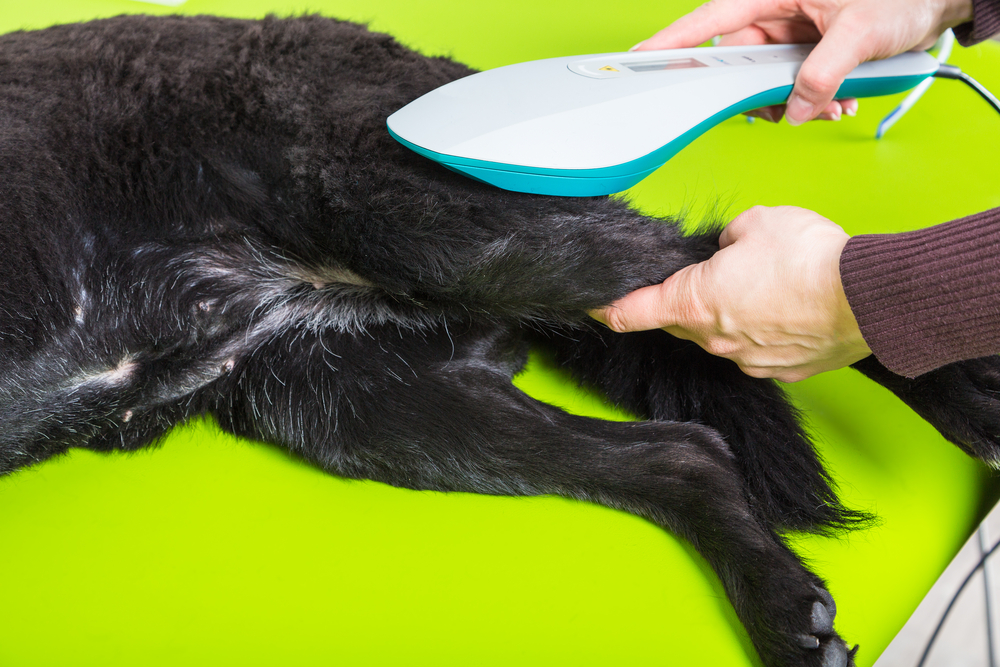Laser therapy promises to provide pain relief, reduce inflammation, and speed healing in dogs and cats with various medical conditions. This may sound too good to be true, but scientific studies prove the treatment’s efficacy in many clinical situations. Laser therapy also offers an excellent safety profile and is suitable for nearly all pets. The Neighborhood Veterinary Centers La Marque team shares how laser therapy works and how the treatment can help your furry pal.
Laser therapy mechanisms in pets
Veterinarians use several laser types in everyday practice, including “hot” surgical lasers that cut through tissue and “cold” lasers for therapeutic treatments. The cold laser uses a specific light wavelength, usually red or near-infrared, to penetrate deep into the target tissues. There, in a process called photobiomodulation, the light energy stimulates changes inside body cells, ramps up energy production, and attracts new cells to help repair the area. This process is responsible for the many benefits of laser therapy, including:
- Reduced pain — Increased endorphin levels and slowed nerve pain signals reduce injury pain.
- Reduced inflammation — Laser therapy diminishes inflammation by shutting down pro-inflammatory chemical mediators and improving lymphatic drainage.
- Increased circulation — Vasodilation during and after treatment brings oxygen and healing factors to the injured site.
- Faster healing — Laser therapy stimulates pro-healing cytokines and growth factors to encourage new blood vessel growth and help cells replicate and migrate to close wounds faster.
Pet health conditions that benefit from laser therapy
Laser therapy benefits most conditions associated with pain, inflammation, or delayed healing, including:
- Arthritis
- Joint and soft tissue injuries
- Bone injuries
- Dental disease
- Surgical incisions
- Non-healing wounds
- Skin and ear diseases
- Intervertebral disc disease
- Trauma
- Nerve injuries
Laser therapy safety in pets
Laser therapy has an excellent safety record when prescribed and administered by trained veterinary professionals. Side effects occur rarely, because the laser is not consumed or metabolized like drugs, and laser treatments will not interact poorly with any other therapies. This wide safety margin makes laser therapy ideal for pets who cannot take medications or undergo surgeries.
However, laser therapy has a few minor risks, including:
- Eye damage — Cold lasers should not be used near or on the eyes, as retinal damage could result. All parties must wear protective goggles during treatments.
- Thermal burns — The laser probe must remain in constant motion to prevent concentrating its slight warmth over a small area.
- Fetal damage — Lasers can cause problems and should not be used for pregnant females.
- Cancer metastasis — Cancer patients should not receive laser therapy, because cancer cells can be stimulated inadvertently and spread.
What to expect during a pet laser therapy session
Most pets enjoy the laser’s warming sensation, which relaxes their muscles and minds. You can expect to spend around 10 to 20 minutes in an exam room with your pet while a trained team member administers the treatment that the attending veterinarian prescribes. Aside from wearing a pair of silly goggles, the process is quick and painless—literally. Most pets feel immediate relief when treatment is finished, but long-term change requires multiple treatment sessions.
Laser therapy in a multi-modal pet health treatment plan

Laser therapy can be used alone in pets who do not tolerate other treatments but is often most helpful as part of a multimodal treatment plan. Many pet owners see improvement in their pet after a few weeks of laser sessions. For the most benefit, your pet will first visit a few times per week, and then taper down to a maintenance schedule as their condition improves.
Pet owners may be tempted to purchase their own lasers to eliminate their need for frequent veterinary visits. Unfortunately, these devices are extremely low-powered to ensure their safety, which means they often aren’t strong enough to significantly impact your furry pal’s condition. Stick to office-administered treatments for safety and efficacy.
The quest for a safe, effective, non-invasive, and affordable treatment for painful conditions in pets is over—laser therapy is the ideal solution for Southeast Texas pet needs. Contact our Neighborhood Veterinary Centers La Marque team to add laser therapy to your pet’s treatment plan, or to learn more about laser therapy’s many benefits.






Leave A Comment